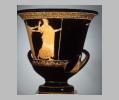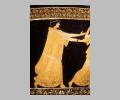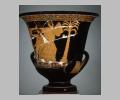| Collection: | Paris, Musée du Louvre |
| Summary: | Side A: Apollo and Tityos |
| Ware: | Attic Red Figure |
| Painter: | Attributed to the Aegisthus Painter |
| Date: | ca. 470 BC - 465 BC |
| Dimensions: | H. 0.505 m |
| Primary Citation: | |
| Shape: | Krater |
| Beazley Number: | 205657 |
| Period: | Early Classical |
Decoration Description:
Side A: Apollo, dressed in Ionic chiton hiked up, quiver at back, and with a wreath in his hair, runs in pursuit of a giant, holding out his bow in his left hand and long knife in his right. The giant, Tityos, with straggly beard and frightened look on his face, wears a panther skin knotted around his chest and a fillet. He grasps Leto around the waist and looks back at Apollo. Leto, with three arrows stuck in a clod of earth on her right shoulder, wears Ionic chiton, himation, stephane, and bracelets; she holds up her left sleeve and runs to the right while reaching out to Apollo, her son. A palm tree closes the scene at the right (perhaps a reference to Delos, Leto's refuge).
Side B: A woman enveloped in Ionic chiton and himation wearing bracelets and fillet, runs and extends her arms to an old man. He is dressed in the same garb (dilute glaze delineates the bodice folds) and fillet, has added white hair and beard, and holds a staff with palmette finial. He holds up his right arm to ward off the woman while running to the right.
The ornament under the rim is a double complimentary band of palmettes alternating with buds, and the decoration between the handles is a single band of palmettes alternating with buds.
The artist is an early classic painter of large pots whose style may be derivative from the Copenhagen Painter's later works (
Shape Description: Calyx krater
Inscriptions:
On A, to the left of the bow,
Sources Used:





